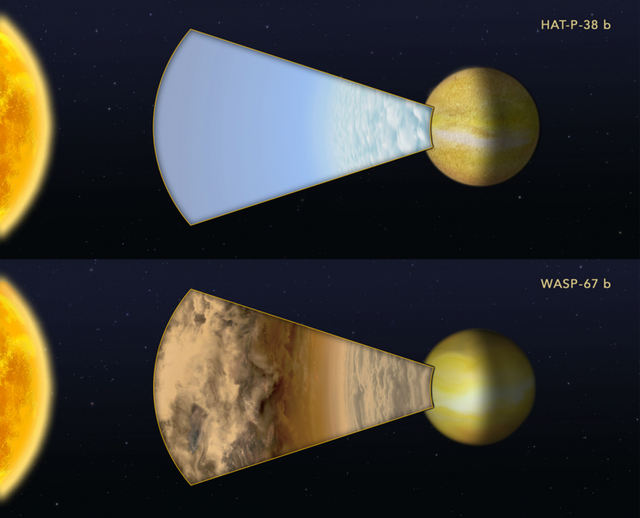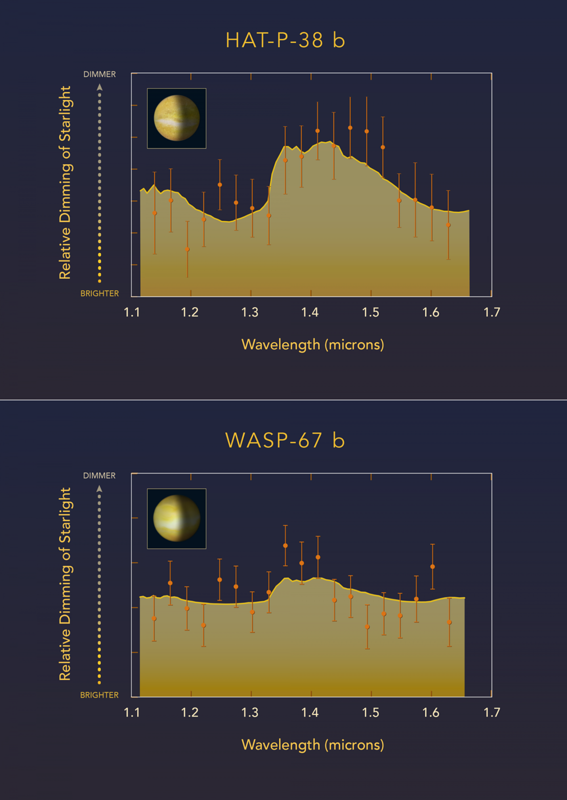Two exoplanets -how different they are
There are two planets, of approximately equal masses, orbiting alike stars at equal distances. It is easy to suggest that their atmospheres will be similar. Scientists used Hubble telescope to study such twins - hot Jupiter exoplanets (common name for exoplanet of mass comparable to that of our Jupiter, but orbiting star at very close distance). What they found surprised them.
First planet - WASP-67 b, orbiting sunlike star with mass 0.87 MSun. Planet has mass of 0.42 MJup and orbits star in 4.5 days
Second planet - HAT-P-38 b. Mass of its star 0.886 MSun. Planet's mass 0.267 MJup and orbital period 4.64 days.
Their orbits are much closer to the star than Mercury which orbits the Sun in 88 days. According to current theories they were formed in other parts of their star's systems and later migrated to inner areas. Both stars are yellow dwarfs, as our Sun.

Image: Science: NASA, ESA, and G. Bruno (STScI)
Astronomers measured how light from each parent star is filtered through each planet's atmosphere. HAT-P-38 b did have a water signature indicated by the absorption-feature peak in the spectrum. This is interpreted as indicating the upper atmosphere is free of clouds or hazes. WASP-67 b, has a flat spectrum that lacks any water-absorption feature, suggesting most of the planet's atmosphere is masked by high-altitude clouds

Image: Science: NASA, ESA, and G. Bruno (STScI)
HAT-P-38 b has a water signature indicated by the absorption-feature peak in the spectrum. This is interpreted as indicating the upper atmosphere is free of clouds or hazes. WASP-67 b, has a flat spectrum that lacks any water-absorption feature, suggesting most of the planet's atmosphere is masked by high-altitude clouds.
Lead researcher Giovanni Bruno of the Space Telescope Science Institute in Baltimore, Maryland, explained:
What we're seeing in looking at the two atmospheres is that they're not the same. One planet—WASP-67 b—is cloudier than the other—HAT-P-38 b. We don't see what we're expecting, and we need to understand why we find this difference [....] The effect that clouds have on the spectral signature of water allows us to measure the amount of clouds in the atmosphere. More clouds mean that the water feature is reduced
Researchers conclude that one planet formed differently than the other, under a different set of circumstances.
Co-investigator Kevin Stevenson said:
You can say it's nature versus nurture. Right now, they appear to have the same physical properties. So, if their measured composition is defined by their current state, then it should be the same for both planets. But that's not the case. Instead, it looks like their formation histories could be playing an important role
Both planets are tidally locked, that is they always face the parent star with the same side, as our Moon is facing Earth. But unlike the Moon, this means that they have very hot day side and a cool night-side. Instead of sporting multiple cloud bands like Jupiter does, each probably has just one broad equatorial band that slowly moves the heat around from the day-side to the night-side. The average temperature on the level of upper atmosphere layers is more than 700 C and they probably consist ofsodium sulfide and potassium chloride.
To better understand the difference, more observations needed, hopefully with soon-to-be-launched James Webb telescope.
Source: https://phys.org/news/2017-06-hubble-tale-exoplanets-nature-nurture.html